Abstract
Occupant behavior controls a building’s energy system to adapt the indoor environment, significantly increasing building energy consumption. Occupant behavior, which refers to the occupancy inside a building and their interaction with building systems (windows, blinds, thermostats, lighting and appliances, etc.), has been largely overlooked in building energy performance analysis. These factors make it essential to design sustainable buildings. It is widely acknowledged in the literature that there is an alarming performance gap between the estimated and actual energy consumption in buildings. This paper proposes a systematic literature review on energy-related occupant behaviors and their implications for energy performance. It aims to better understand occupant behavior, existing behavior modeling approaches and their limitations, and key influential parameters on building energy performance. It is based on a survey of ScienceDirect, Web of science and Scopus scientific databases, using their bibliometric analysis tools together with the VOSviewer software. Finally, this study identifies the following significant research gaps for future development: limitations of the generic and robust occupant behavior model; lack of actual data for validation; lack of research on different types of buildings (institutions, university buildings); limitations of considering all factors which influence occupant behavior; missing the detailed realistic situations of occupant behavior; integrating building information modeling (BIM) into building energy modeling.
1. Introduction
Over the past decade, there has been a significant increase in the need to ensure buildings′ sustainability. The construction sector has enormous potential to increase efficiency and reduce greenhouse gas (GHG) emissions in order to make a positive contribution to tackling global climate change [1]. The impact of climate change on the environment and human resources is forcing governments to strengthen policies on carbon emissions. An example of carbon policies is the European Union’s (EU) target to reduce carbon emissions by 40 percent by 2050 [2]. Therefore, climate change is the greatest threat and the most significant environmental challenge of today and, indeed, of tomorrow.
There are initiatives to address the challenge of anthropogenic emissions contributing to climate change and achieving pressing global targets for reducing energy consumption [3]. For example, the Paris agreement and the Leadership in Energy and Environmental Design (LEED) in the United States agreed to consider the influence of occupant behavior on minimizing climate changes. Considering the behavior of the occupants at different stages of the life of the building has a significant effect on increasing the energy efficiency of the building and reduces its environmental impact [4,5,6]. Therefore, it is essential to estimate energy demand at different stages of the building, from conception to operation.
Research shows that buildings are a key sector to impact energy demand and environmental pollutants. The building sector consumes almost 30% of total global energy, revealing great energy-saving potential, and system operation accounts for nearly 50% of the entire energy cost [7]. Another study confirmed that, in Iran, the construction industry consumes about 35 percent of the country’s total energy. In the USA and Canada in 2018, the energy consumption of buildings covered 43% and 11% of the total energy (80% of the energy consumption occurs during the operating phase of the building) [8,9,10]. Likewise, in Japan, China, India and Thailand, building energy consumption accounts for 26%, 35%, 35% and 15.4%, respectively [11]. Finally, in the EU and UK, energy use for the building sector represents more than 40% and 39% of Europe’s energy [12,13]. According to the International Energy Agency, the construction sector is responsible for 40% of all GHGs, significantly contributing to global warming. Moreover, in recent years, this emission related to the building sector annually increases by 1% [13]. Therefore, the building sector is one of the areas that generates an energy imbalance between demand and energy sources and generates emissions into the environment.
To address the potential energy and GHG crises, in the Kyoto and Paris Agreement, there is an international imperative to reduce energy consumption and its associated anthropogenic emissions that contribute to global climate change and pollution [3]. For instance, the European Commission has defined a clear 20-20-20 target to reduce energy consumption by 20%, reduce carbon dioxide emissions by 20% and increase the share of renewable energy by 20% [12]. However, the next overall aim is to reduce GHG emissions to be between 60 and80% by 2050 [2].
In this context, the targets set by the EU might be met by the year 2050 by proposing methods for solving building energy efficiency issues as (i) implementing an intelligent controlling strategy to building energy-consuming equipment, (ii) maintaining equipment to maximum efficiency and (iii) increasing the environmental awareness of the occupant. Occupant behavior is one of the main sources of uncertainty in building energy modeling due to considering standardized schedules or predefined inputs that are oversimplified descriptions of the complex reality [9,14]. However, the dynamic behavior of occupants is difficult to analyze in numerical terms. Energy simulations are used to analyze complex and dynamic inputs.
The purpose of this paper is to undertake a comprehensive review of existing studies in this area to identify research trends and gaps for future studies.
2. Methodology for the Literature Analysis of the Behavior of Buildings and Their Impact
This paper focuses on collecting relevant information on occupant behavior modeling and integrating this into building performance simulation. Figure 1 illustrates that the approach of this study is based on the strategic aspect of the research environment regarding issues related to occupant behavior modeling integrated with energy performance simulation.
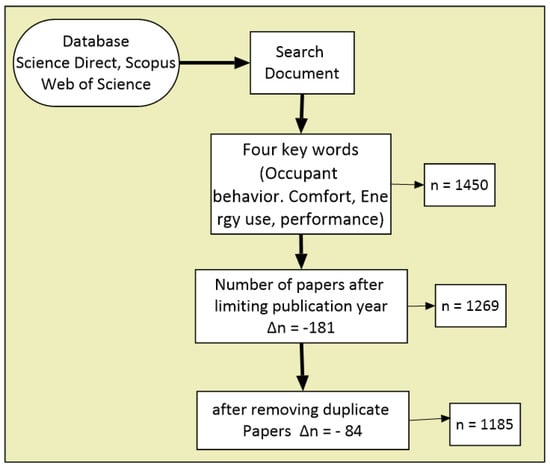
Figure 1.
Research flowchart.
The literature review searched for different published and peer-reviewed papers, considered as the most valuable source of information. The systematic review of the research was conducted using Science Direct, Scopus and Web of science as the search engine databases. Their integrated search engine was used to identify the relevant documents and to group them based on pre-determined criteria such as publication year, citations, relevance to form an inclusive set relating to the research area. The keywords used in the literature search were “occupant* OR user OR human” and “behavior* OR behaviour and building* and energy*”. These were the subject of a “full text” search (title, abstract, keywords, text body), returning many results. To limit the number of retrieved papers, and emphasize the most relevant ones, the following requirements have been applied:
- Only “Review” and “Research papers”;
- These articles must be written in English;
- These articles are available electronically;
- Articles must be from 2010 to 2020 (rise in interest in occupant behavior);
- Articles which are directly related to the objective of the review.
Systematic literature reviews are based on 4 steps: (1) the documentation of review requirements, (2) the commissioning of a review, (3) the conduction of research and (4) the analysis of the review.
In this paper, the review process was, therefore, performed using the following steps proposed by Kitchenham [15]:
- Titles and keywords analysis—Selection of articles by reviewing their titles and keywords using search strings.
- Snowballing—Including additional documents based on checking references to previously selected documents. This process can be repeated many times as new documents are found; however, only the first repetition was applied in this work.
- By abstract selection—Using the abstract for adding and removing criteria for nominations to be designated for the next stage.
- Full-text selection—Full text of the candidate papers from the previous stage, using the adding and removing criteria for the final selection [16].
At the end of the search process, 1185 articles were selected based on the proposed research topic and keywords in Figure 1. Figure 2 shows the annual distribution of retrieved papers by scientific database. Figure 3 presents the five (5) journals that are the most represented by the retrieved papers and their distribution in the 3 searched databases.
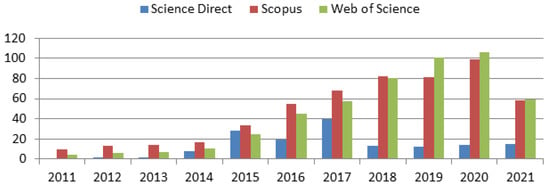
Figure 2.
Distribution of published papers per year.
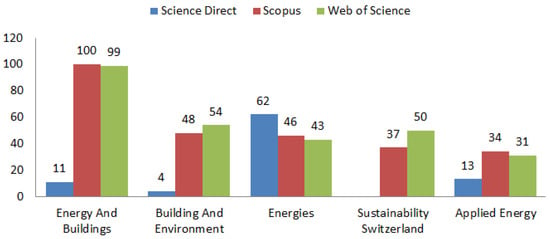
Figure 3.
The top five journal found in the systematic review from the three databases.
Initially, a total of 1450 papers were retrieved from science libraries. Refining was subsequently applied because not all documents were relevant to this review. Only documents published in the period 2010–2020 identified as “review and research papers” were retained. The reason to choose these years is the recent rise in interest in occupant behavior. After the detailed selection, a total of 1185 articles were selected for further general analysis.
According to the systematically reviewed papers, the most frequently used keywords by the researchers in this topic area are “occupant behavior”, “building efficiency”, “building performance”, “thermal comfort” and “energy use/consumption”, followed by “machine learning” and “energy management”, as shown in Figure 4. Thus, this shows the relevance of the behavior of the occupants associated with the energy saving of the building. The term with the highest number of links is the occupant behavior.
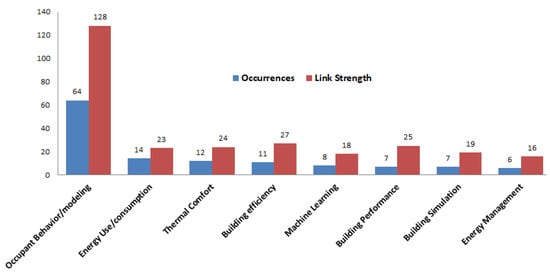
Figure 4.
The frequency and strength of the eight keywords.
3. Co-Occurrence of Keywords
By browsing through the keywords of the literature articles and conducting a comprehensive review, VOSviewer tools can be used to identify sensitive topics using clustering techniques. In this paper, a minimum of five (5) co-occurrences was used as a threshold to map the keywords (Figure 5). Here, circles represent the number of keyword co-occurrences, while lines connecting them represent those that could be retrieved in the same paper. Therefore, the bigger a circle is, the more a keyword is present in the literature review, and the bigger a line is, the more the connected keywords are related in the literature. Finally, the generated color code determines the clusters, grouping the keywords by topic. As shown in Figure 5, the research area is divided into four main sections, some of which are related to building applications (office, residential, social and commercial), building occupant behavior (window opening/closing and adaptive actions), building energy performance (energy management, energy use and thermal comfort) and building HVAC systems (heat pump).
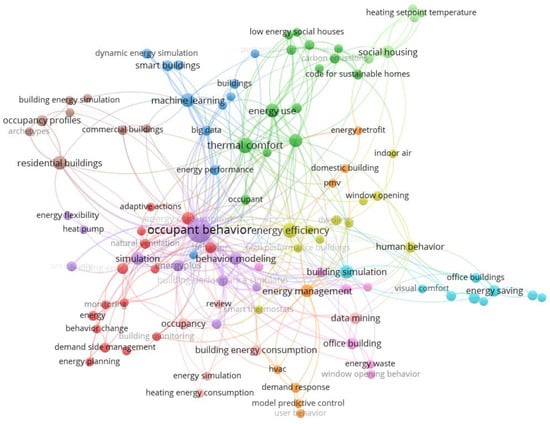
Figure 5.
A network of co-occurrence of keywords from literature review.
Figure 6 illustrates the keywords related to the occupant behavior in the area of building energy simulation from 2016 to 2019. The color of the circle indicates the shifting focus of the research topics. It shows that research in this area is shifting from occupation to modeling occupant behavior and building simulation. Most researchers have looked at certain behaviors of occupants, such as opening windows. Therefore, much work is needed related to the other types of behavior changes that impact a building’s energy efficiency (thermostat use, opening/closing doors and a combination of both). In addition, it shows that building energy simulation was carried out for residential and office buildings; there is no work on multi-purpose buildings, which indicates that further investigation is required for these. Finally, the color code indicates the average publication years of keywords. This makes it possible to estimate the popularity of a subject. For instance, the keywords in the upper left corner of Figure 6 including “machine learning”, “heat pump”, “building energy simulation” and “big data” are in yellow, meaning that these subjects are trending, while “data mining” and “office building”, in purple, are the subject of older interest.
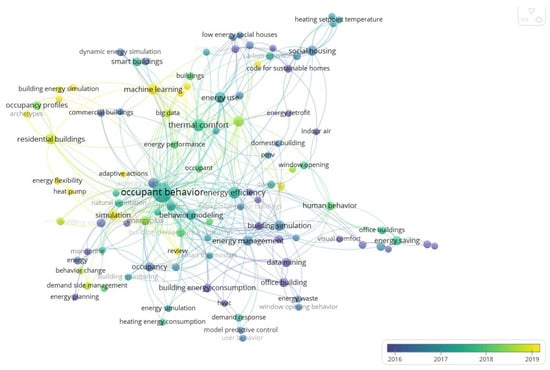
Figure 6.
Bibliographic map and network based on co-occurrence.
4. Overview of Occupant Behavior and Brief Review of Modeling Approaches
Occupants can influence indoor energy performance by interacting with building equipment. Energy-related occupant behavior in buildings can, therefore, be defined as occupants’ behavioral responses to discomfort, and their presence, movement and interactions with building systems that have an impact on the performance (energy, thermal, visual, acoustical and IAQ) of buildings [17]. However, due to physical, physiological and psychological differences between occupants, and other external factors such as economic factors, users do not “receive, recognize and act” in the same way [18]. They may adapt buildings to their own thermal comfort and improve indoor air quality (bringing in fresh air and eliminating air pollution and odor), and acoustical (avoiding unwanted noise and vibrations), visual (by controlling lighting (luminance ratios), reflections and glare) and thermal (controlling indoor air temperature) conditions (Figure 7).
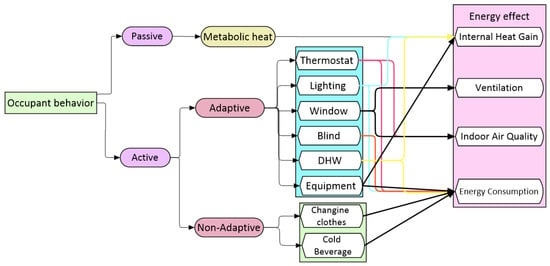
Figure 7.
Types of occupant activities affecting building energy consumption.
Thermal comfort is defined as “the conditions of mind that express satisfaction with the environment” [19]. A comfortable environment is a subjective state where the individual is neither too hot nor too cold. It occurs when the temperature and humidity of the air immediately adjacent to the body lie in between narrow ranges, where the air movement is “pleasant” and the air quality provides a sensation of freshness [20]. An adequate comfort zone with temperature and humidity where 80% of occupants do not feel dissatisfied, with summer and winter clothing, when the metabolic rate is between 1 and 1.3 met, i.e., during sedentary activity such as sitting in a lecture room or office, and average airspeed below 0.2 m/s is shown in Figure 8 [21].
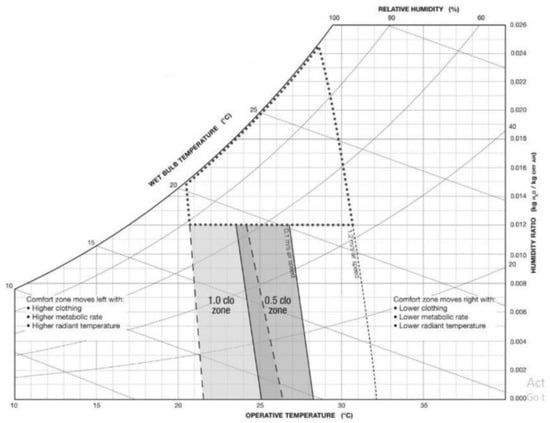
Figure 8.
Psychrometric chart showing the comfort zone.
Despite the subjective nature of thermal comfort, two quantitative formulas, first developed by Fanger [22], are used for its measurement: predicted mean vote (PMV) and predicted percentage dissatisfied (PPD). Fanger’s thermal comfort experiments did not enable individuals to interact with the environment; building occupants were considered as passive receivers of the thermal environment controlled by HVAC systems [23]. However, occupants are active agents, rather than passive ones. They find a way to restore their comfort conditions if they do not feel comfortable in their environments [24,25]. Occupancy and occupant interaction in building simulations have been modeled in deterministic and stochastic ways, and these types of modeling are explained in the following subtopics.
4.1. Deterministic Occupant Modeling and Limitation
Traditionally, most building energy simulation tools reduce occupants to deterministic behavior (occupant schedules), used as direct inputs. In building performance simulation (BPS), occupant behavior and occupant interaction with building systems reflect environmental changes to secure their comfort, considered as deterministic input. This provides a simple representation of occupant behavior throughout the entire building life cycle [26]. For instance, in building simulation tools, the occupant behavior data are derived from the American Society of Heating, Refrigeration and Air Conditioning Engineers manuals. However, these manuals imply consistent schedules for different buildings, which can be used to design the interaction between the building and the user when occupancy and operating schedules are not defined. These schedules represent the occupancy or occupant behavior in the form of a daily profile, and this is applied differently on weekdays and weekends. A deterministic way of representing occupancy or building energy use is easy to use and interpret. However, the main limitations of this approach are steady-state and weak capturing of the stochastic behavior of the occupant [27].
Despite the simulation assumptions, there is no certainty that occupants will be present in the space at fixed intervals or execute the predicted behavior regarding known environmental factors’ triggering. This type of assumption leads to an estimate of the difference between the simulated energy consumption and the real energy consumption of the building. In their studies, L. ledo and Caroline et al. [21,28] found that by estimating energy performance at the design stage, at which point there is no complete information on the occupation and behavior of occupants in schools, offices and universities, the differences ranged from 60% to 70% for schools and offices, while universities recorded a difference of 85% between the actual and expected energy consumption. Similarly, D. yan et al. [29] indicated that the difference in energy performance of a building due to an occupant behavior effect can sometimes be as much as 300%. Additionally, R.C. Sonderegger [30] suggested that up to 70% of the variation in energy demand in buildings occurs due to the oversimplification of occupant behavior. Similarly, Gilani and Brien, 2019, ([14,31,32]) indicated that the measured electrical power consumption in a case study was 30% different from what was simulated [33]. According to A.D. Galasiu et al. [34], an individual’s preferred work plane illuminance ranged from 230 to 1000 lux. Simulation results may indicate that maximizing window area will maximize the use of daylight. However, increasing a building’s window area will cause the window shades to close to protect from glare, and this significantly increases the use of electric light energy [35]. These results indicate the misunderstanding of occupant behavior as fixed or deterministic input, meaning that estimated energy performance does not reflect reality in any BPS.
4.2. Stochastic Occupant Behavior Modeling
We can consider occupant behavior to be stochastic, since behavior varies between occupants and may evolve over time and is the result of complex relationships between contextual factors, adaptive triggers and non-adaptive triggers [14,36]. Stochastic behavior models can interpret the state of a building element as a behavioral proxy or, more precisely, state transitions of a building element or indoor environment changing at discrete time steps (e.g., every 15 min) or discrete events [37].
As noted above, the attempt to reduce the performance discrepancy by accounting for inconsistency between occupants has led to the development of models addressing the stochastic nature of occupants’ behaviors. There is related research on integrating stochastic occupant behaviors, for instance, Zhou et al. (2012) [16,38] developed a light switch-2002 stochastic occupancy model to predict office lighting profiles. According to C.F. Reinhart, (2003) [39], monitoring lighting control in ten offices, Taylor et al. [40] observed a relationship between closing shades and the magnitude of vertical irradiance, but opening shades did not reveal a clear relationship to the amount of incident solar radiation. Y. Zhang et al. [41] studied the factors influencing blind operation in a naturally ventilated building [29]. Finally, E. Vorger. [42] prepared probability distributions of French survey data to predict long-term absences due to holidays and illness.
Others used a complex approach, for instance, Feng et al. developed a software module to simulate occupancy based on the Markov chain concept. Similarly, J. Virote. [43] improved the occupant behavioral model based on hidden Markov models to predict building energy consumption using actual measured data with stochastic knowledge. They reported that occupant behavior continues to play an important role in overall energy consumption, although the technologies used in buildings are not yet effective. The models they developed showed that different living styles produce different energy consumption patterns and provided useful information to simulate the impact of the occupants on the building in terms of energy consumption. Additionally, B. Dong et al. [44] developed semi-Markov models to optimize occupancy schedules for lighting and HVAC control related to occupant presence and behavior pattern recognition. Similarly, Erickson et al. in [45] contributed to the temporal dynamics of occupancy by developing two advanced Markov chain models from ground truth data collected from a sensor network. Their study showed good accuracy in occupancy estimation and 42% annual energy savings could be achieved by implementing real-time occupancy data into HVAC work schedules. The most recent agent-based modeling has been used even for the consideration of individual interest. M. Jia et al. [45] delivered a stochastic model capable of utilizing randomness in building operations. The model also used agent-based modeling with respect to time-related factors. The stochastic occupant behavior modeling method fails to consider the interaction of individuals with the building system and with each other.
4.3. Multi-Agent-Based Modeling
A multi-agent simulation (MAS) consists of several agents interacting with their environment, capable of flexible, autonomous action and interconnected to function in a way exceeding the capacity of any single agent. Agents have three main characteristics: reactivity, pro-activeness and social ability [35,46,47,48,49]. Reactivity is the ability of agents to respond to changes within their environment. Proactivity refers to one’s goal-oriented behavior, while social ability refers to the ability of agents to interact with other agents in order to achieve their goals, as depicted in Figure 9. The environment that the agent can perceive affects the agent’s perception, including the quality of the indoor environment, thus enabling the agent’s behavioral options to adapt to the environment [50,51,52].
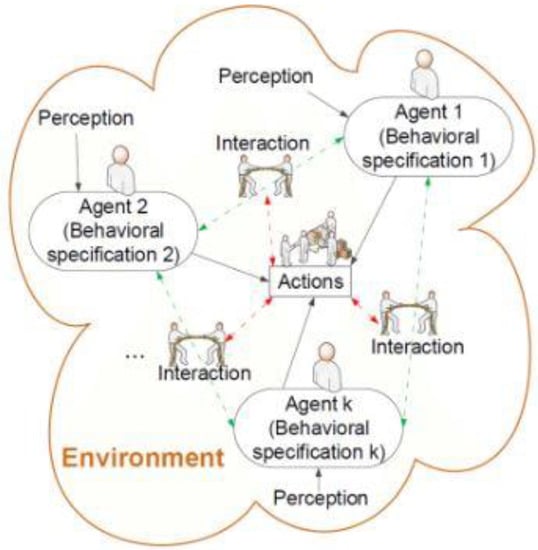
Figure 9.
MAS occupant system interactions.
MAS could be used to better simulate and understand how occupants’ behavior and activities impact energy consumption in buildings. MAS follows a bottom-up approach which addresses the behavior and interactions of agents at a micro level and their influence on the macro level (energy consumption within the building). This can be achieved through an unobtrusive wireless sensor network from which information can be gathered on individual occupants going about their normal daily activities, reacting to their environment, adjusting shading devices, opening windows or turning on the air conditioning. P. Davidsson et al. [53] introduced a MAS framework using personal comfort agents, room agents and environmental measurement agents for energy savings and occupant comfort in office buildings. More than the system developed by Haberman, the increase in individual satisfaction was achieved by adjusting the light and temperature according to individual preferences. Building on the previous work involving MAS systems, L. Klein et al. [11] developed a multi-agent comfort and energy system to simulate alternative management and control of building systems and occupants.
Agent cognition is often based on the belief–desire–intention (BDI) model [54]. The BDI approach has been the most prominent and sustaining. Beliefs are the set of information that an agent has at a certain time about the environment in which they reside. They are the knowledge set that an agent holds about theirs environment. Desires are long-term goals that the agent tries to achieve. These desires may change over time. Intentions are the agent’s short-term goals or the goals that an agent is currently trying to achieve. In this system, an agent has beliefs about the current state of the environment and related desires about what they want to achieve; they commit to an intent, which is the desire they want to achieve. A plan is made up of a set of actions, preferably to achieve their intent, where agents can obtain a belief about the state of the current environment from a building performance simulation. For instance, Kashif et al. [55,56] developed a similar approach to predict the use of fridge-freezers, where an occupant would first perceive their hunger, secondly, conceive a desire based on social norms, household rules and culture, then finally perform an action: remove food from the freezer, increase the electrical load on the fridge and then cook. These approaches attempt to summarize the human decision-making processes involved in each activity. However, they can lead to very complex and unpredictable models with weak empirical bases. Paradoxically, this is their strength, as relatively little data can be used to simulate reasonably reliable generalizations.
Occupants interact with building systems to respond to change through adaptation and learning [57,58]. The MAS provides an opportunity to further understand the impact of occupant behavior on energy consumption. While significant advances have been made in research on multi-agent modeling of occupant behavior, most traditional simulations have not incorporated these models. Most of the studies on the impact of occupant behavior have not considered the implementation of simulation tools developed in a dynamic, real-time and independent platform. Therefore, the above underlines the importance, advantages and limitations of integrating the stochastic occupant behavior model into simulation tools.
These models cover a complete range of energy-related behaviors, but some parameters have not yet been covered.
5. Parameters Influencing Energy-Related Occupant Behavior
The energy consumption of a building is influenced by the physical and thermal characteristics of the building and the behavior of its occupants. In this study, occupant behavior mainly refers to the occupancy and the interaction with the physical systems of the building in response to the external and internal environment, which can vary according to individual (psychological, physiological) and social parameters. Therefore, energy-related occupant behavior impacts building energy consumption and indoor environmental quality (comfort and indoor air quality). Thermal comfort varies from person to person due to psychological, biological, physical and social (occupant–occupant interaction, cultural norms and economics) factors. These directly affect building energy performances [59].
According to Fabi et al. [60], driving forces refer to parameters that influence the occupant’s interaction with building systems and equipment. IEA EBC Annex 66 specified that occupant behavior is influenced by external factors such as culture, economy and climate, as well as internal factors such as comfort, psychology and physiology (Figure 10 and Table 1). Figure 10 shows how occupant behavior influences building operation, which will inherently affect energy consumption and indoor environmental quality. This process triggers a short-term effect on occupant behavior through psychological, physiological, and economic factors, as well as some long-term factors such as comfort, culture, and the economic situation. Therefore, occupant behavior and building performance are highly coupled, with multiple feedback loops, making consistency challenging.
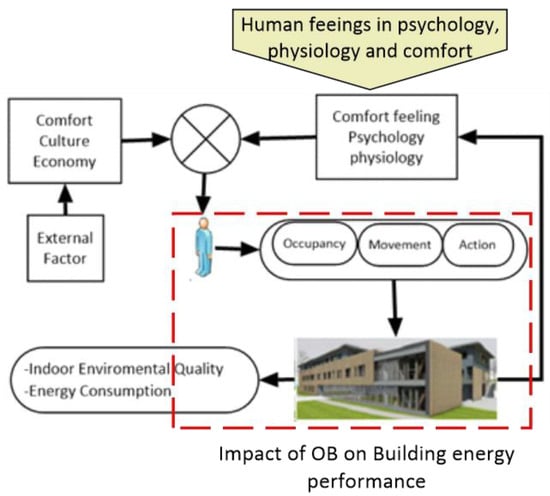
Figure 10.
Relationship between occupants and buildings (IEA EBC ANNEX 66).

Table 1.
Internal occupant behavior-influencing factors.
Apart from the above, Weerasinghe et al. [61] reviewed occupants’ behaviors inside buildings, assessing the main driving factors for their actions categorized into six main types of factors: physical environment, psychological, physiological, contextual, social and time-related factors, as depicted in Figure 11.
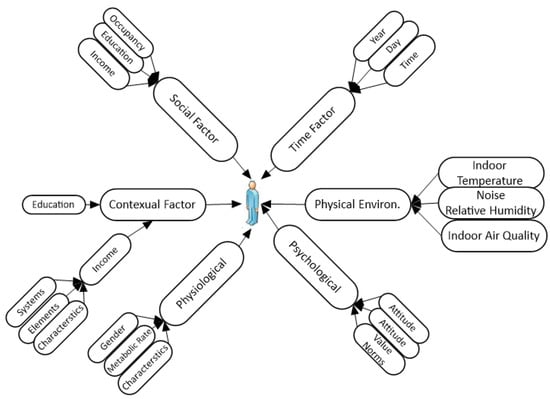
Figure 11.
Factors influencing occupants’ behavior regarding energy use.
6. Previous Related Research on the Impact of Occupant Behavior on Building Energy Performance
The featured studies are classified according to the methodology used, the building type, the occupants’ interaction with the building systems and the effects of occupant behavior on energy simulation and energy discrepancy as depicted in Table 2.

Table 2.
Review papers related to published year, type of occupant behavior, methodology, building type and the impact of occupant behavior on building performance (x_ not considered, √_considered).
From Table 2, we can conclude that the main source of inaccuracy in energy simulation is due to a simplistic or misinterpretation of occupant behavior. Conversely, considering the behavior of the occupants when estimating the performance of the building significantly decreases the energy gap or significantly increases the quality of the simulation. For instance, C. Yu et al.’s [62] research showed an improvement in energy-consumption prediction accuracy by 14% of the total building floor area and 16% of the total living area. Similarly, L. Klein et al. [11] found a 12% reduction in energy consumption and a 5% improvement in occupant comfort were realized, as compared to the baseline reference.
In this study, residential and office buildings, respectively make up 40 and 33 percent of the literature review. Similarly, commercial and educational environments, which make up 6 percent of the same review, are not adequately covered (Figure 12). Therefore, further research is needed to determine the impact of occupant behavior on these building types.
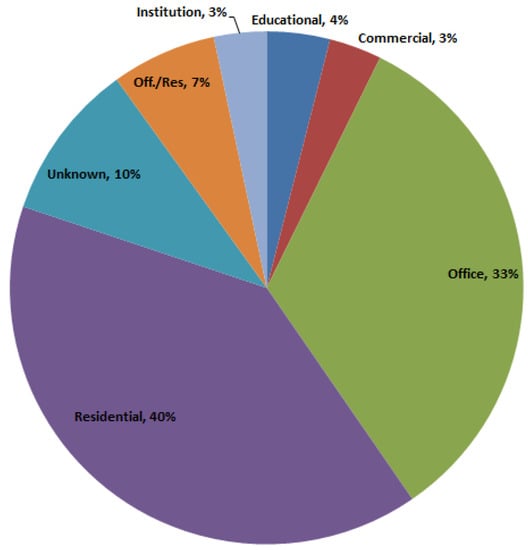
Figure 12.
Building types used in the literature review.
Most of the research on this subject focuses on the influences of the behavior of the occupants on the energy performance of the building, focusing on a particular behavior. As shown in Figure 13, windows, lighting and occupancy cover 20, 18 and 32%, respectively, of all building system interactions. These are the behaviors that attracted more than 60% of the previous researchers in this field, even though the others have an impact on the energy performance of the building. Although the subject areas of domestic hot water (2%) and building heating systems (radiator, 2%, and floor heating, 2%) have previously been limited, these parameters have started to appear in the current journals.

Figure 13.
Different occupant and building system interactions.
7. Building Performance Simulation and Limitations
Building performance simulation (BPS) is the most important approach for analyzing the energy consumption at the design stage of a building. It depends intrinsically on the design parameters of indoor environment quality [2]. BPS helps to speed up building design, increase the efficiency of a building and it also possible to it use for deciding on a wide range of designs and selecting the optimum [84]. Therefore, BPS has become an important evaluation method during the design process and renovation of existing buildings to predict energy performance based on the building’s physical characteristics and usage patterns. The importance of energy simulation is increasing with the tendency for more complex building designs and higher performance requirements in terms of sustainability. The first simulation tool developed in the 1980s was used to calculate the energy consumption of buildings from deterministic inputs using a simple mathematical formula. The simulation results included area temperature, energy consumption of HVAC equipment and indoor occupant comfort. Based on these outcomes, energy experts decided to select a better design for achieving energy efficiency goals and environmental impact [19].
Currently, simulation tools use dynamic inputs to estimate different complex outcomes. To use a simulation, the first and most important requirement is identifying the key parameter that can be incorporated into the simulation for estimating building energy [85].
Energy consumption of buildings is related to various factors including the thermo-physical properties of the building elements, their construction technical details (energy-efficient building elements may not perform efficiently if poorly constructed), climatic location characteristics, the quality and maintenance of the installed HVAC system and occupants’ behavior and activities related to energy utilization [59,86] (Figure 14).
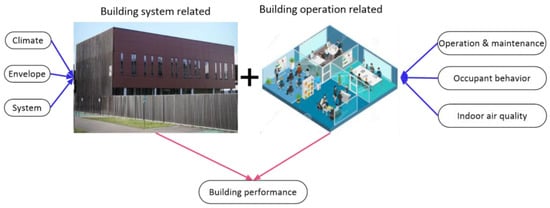
Figure 14.
Factors influencing building energy consumption.
The occupant behaviors have a significant impact on energy performance. However, this is not yet accurately represented in simulations. Occupant behavior impact on building energy performance is much larger than the thermal properties and processes. For example, B. Bordass et al. [87] stated that the actual energy consumption in Probe’s air-conditioned offices was twice as high as predicted. A study of 15 schools in the UK showed that actual electricity consumption was around 60 to 70 percent higher than expected [88]. Building energy simulation failing to predict these transition parameters leads to prediction errors in energy demand models, resulting in a discrepancy between the actual and simulated indoor environmental conditions and energy consumption [1].
A simulation tool is used to estimate building performance in the design, construction, operation and maintenance phases. The input information required to estimate the building energy at the different stages is different. It is difficult to obtain all the required information to input into the model and simulate the building performance. The lack of detailed input data into the modeling can lead to inaccurate energy simulation. For example, lack of detailed thermo-physical properties, work schedule, occupancy, HVAC equipment, building function and occupant behavior may result in simulation inaccuracy.
Energy consumption at the operational building stage evaluation has been analyzed in numerous research works. For example, in their experiment on 248 different apartments, P. Reviewed et al. [30] found that energy demand varies by at least 71% due to occupants’ behavior and individual variation when reacting change in the environmental conditions [89]. In a study of 28 identical houses for two years, Maier et al. [56] found a discrepancy of two in heating energy. Since the houses were identical, the primary reason for the energy gap was the difference between the occupants, or generally due to the occupant behaviors. From Yousefi et al. [7], the variation in the heating and cooling of a residential building due to the changing of window type is 20%. According to L. Visser et al. [90], studies indicate that the difference in energy efficiency between the actual energy consumption and the calculated energy consumption can reach 80% due to the occupant. They concluded that occupant behavior and preferences are significant factors in the gap between the anticipated and the actual energy performance of a building.
Efforts to reduce the performance gap by accounting for variability among occupants have led to the development of models to characterize occupant behavior and integrate it into building performance simulations. This starts from the coupling of occupancy and occupant interaction, for instance, window and occupant presence [8], integration of occupancy and lighting [38] and the integration of occupancy, lighting and window shades [91].
Likewise, when comparing an ideal and worst-case occupant scenario to demonstrate the range of influence occupants have, Gaetani et al. and Muroni et al. [4,92] found improvements in the total electricity consumption prediction from an initial 22.9% average deviation of measurements to 1.7%.
Klein and Kavulya [11] found that a 12% reduction in energy consumption and a 5% improvement in occupant comfort are realized, as compared to the baseline control, from the coupling of occupant behavior models of lights, windows, shades and temperature set points into a building simulation tool. Although efforts combine the dynamic behavior of occupants to demonstrate the impact on building performance, the above integrate completely different simulation tools or focus on a single office building and lack generalization. This is partly addressed by Chapman et al. [93], who developed a multi-agent stochastic occupant behavior model of occupancy, lighting, windows and shades using building simulation tools. However, this approach is also software-specific, so does not support more complex features and has not yet been proven to be validated.
8. Occupant Behavior Modeling and Building Performance Simulation: Toward Integrated Approaches
The last few decades have observed a paradigm towards creating interoperable simulation frameworks that can analyze a complex system effectively when compared to independent and standalone simulation models [94,95]. A co-simulation refers to a framework in which at least two simulators are coupled to communicate and exchange information between them throughout the simulation time, as shown in Figure 15. The overall concept of co-simulations is to model and couple dynamic energy-related behavior on building energy performance simulation tools. The energy-related occupant behavior is grouped into occupancy (no. occupants, arrival, departure, movement) and occupant–system interaction, such as interaction with a window, thermostat set point, equipment, light and window shade [96].
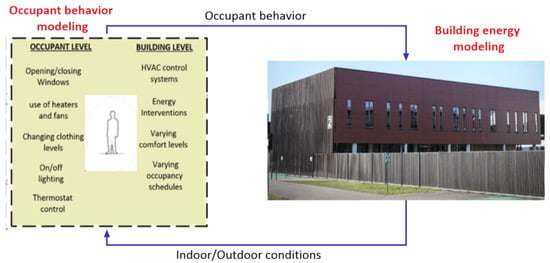
Figure 15.
Co-simulation general framework for building energy simulation.
In building performance simulation, co-simulation is a growing need for performing coupled simulation. Traditional energy simulation tools assume deterministic behaviors to estimate the impact of occupancy and behavior on building energy consumption, which does not accurately consider the stochastic occupant behavior during operation phase of the building [1,97].
For instance, T. Stephane, A. Nicoli et al. [98,99] developed agent-based modeling with an occupant behavior functional mock-up unit that could simulate the presence, movement and interaction with building equipment of each occupant, implementing the functional mock-up interface of EnergyPlus for co-simulation purposes instead of using a separate tool. R. Li et al., M. Jia et al. [82,100] developed a new method to model occupant behavior for a single-occupant office, including control of lighting, plug load and thermostat, using the tool in EnergyPlus that enables the co-simulation framework to couple EnergyPlus with Java via a functional mock-up interface, to analyze the building energy performance. Agent-based simulation was used to model occupants’ operations on windows, doors and blinds and used the Building Controls Virtual Test Bed (BCVTB) to interface the influence of these occupant behaviors on building energy performance [101,102].
J. Langevin et al. [48] used MATLAB to model occupants’ window opening/closing behavior, use of heaters/fans and thermostat set point adjustments, and used the BCVTB environment to represent the effects of these behavioral variation patterns in an energy simulation. Similarly, Nouidui et al. [56,103] used the FMU scheme to couple an HVAC (heating ventilation and air conditioning) module that simulated the variations in sensible and latent heat gain in a room with an energy simulation analysis to represent its energy effects.
Co-simulation allows a more realistic and robust representation of occupant behavior, and its aim is to couple two or more simulation tools, offering a data exchange environment between subsystems. Co-simulation provides a flexible solution that allows simultaneous consideration of network behavior and physical energy system conditions, as well as large system evaluation opportunities [104]. Therefore, co-simulation incorporates the stochastic occupant behavior model into an energy performance simulation and accurately predicts it to address its contribution to reducing the performance gap.
9. Discussion and Research Gaps
A review of the key findings of the literature suggests the following research gaps:
9.1. Limitations of Generic and Robust Occupant Behavior Model
- Occupant behavior is difficult to model due to the stochastic nature and variability of the occupants; it is necessary to explore the generic pattern of their behaviors and integrate the information into the building energy model. In other words, the environmental conditions in which an occupant resides will cause adaptive behavior, while energy consumption may, therefore, be misused. Therefore, a valid occupant behavior model should be able to simulate the actual users’ responses to the different environments.
9.2. Lack of Actual Data for the Validation
- In recent years, many researchers in this field have focused primarily on the impact of occupant behavior on the energy optimization of buildings. The main drawback of modeling the occupant behavior is the difficulty in showing the reality. The dynamics of the occupant not only interact with the building systems, but also individually reflect the changes in their surroundings to maintain their comfort. Coupling the behavior of stochastic occupants in building simulations significantly reduces the uncertainties of the real world. This cannot be ignored, because one of the main objectives of modeling occupant behavior is to reduce the gap between real and simulated energy consumption. However, almost all studies that applied the old model to simulate stochastic occupant behavior are not validated.
9.3. Lack of Research on Different Types of Buildings (Institutions, University Buildings)
- There is a relatively high level of research in the domestic sector. The review research, which studied the occupant behavior impact on building energy performance, has focused on residential and office buildings (40 and 33%, respectively) and very little research has analyzed commercial and educational (3 and 3%, respectively) buildings. The institutional and hospital building sectors (a total of around 3% of the review) are particularly neglected, and require further research due to their significant carbon emissions.
9.4. Limitations of Considering All Factors Which Influence Occupant Behavior
- The limitations of building dynamic simulations regarding occupant behaviors are well known and several studies aim to overcome such obstacles. Occupant behavior models have not yet been established and BPS tools do not enable the consideration of several fundamental variables which influence human behaviors, such as physiological, psychological and social factors [105]. Therefore, one of the main challenges nowadays is to be able to accurately simulate a building’s energy performance with current tools and to predict which share of this consumption is due to occupants’ behavior.
9.5. Considering the Limited Number of Occupant Behaviors
- According to the literature reviewed, different types of occupant interactions with building systems, such as adjusting lighting, thermostat setpoint, windows and shades, were investigated. However, some areas, such as the use of hot water radiators and domestic hot water (DHW), which have a significant impact on energy consumption in an office building, have received slight attention. In addition, future investigations of the relationship between the different characteristics of the occupants are necessary, which will lead to more realistic estimates simulating the energy of the building.
9.6. Limitations of Coupling of Occupant Behavior into Building Energy Simulations
- Many studies contain detailed methods, including case studies, experiments, field measurements, surveys and questionnaires, and simulations. The results clearly show a clear direction in understanding how occupant behavior affects the energy performance of buildings. However, the present results have significantly improved the estimation of the energy behavior of occupants in buildings. Combining the findings of these stochastic occupants with integrated energy performance simulations to reduce the energy gap between predicted and actual values remains a major research challenge in this area [99,106,107].
9.7. Missing the Detailed Realistic Situations of Occupant Behavior
- More recently, multi-agent simulations have been used to optimize the energy consumption of buildings. This environment simulation method provides a realistic method to model occupant behavior, which plays a major role in the building’s energy performance. However, in the current multi-agent approach, where agents are representing occupants’ properties, such as tracking a person’s movement in a given location and counting occupants, the level of detail is negligible [32,46,49,51]. Consequently, the MAS modeling approach to modeling occupant behavior is not new, but the extent to which it covers complex occupant behavior modeling is limited [10,56].
9.8. Integrating Building Information Modeling (BIM) into Building Energy Modeling
- The emergence of BIM provides an opportunity for building engineers, architects and designers to give a solution for building energy modeling limitations such as tedious model preparing, model inconsistency and cost implementations, and propels the modeling process into the digital world. The energy consumption of the building is quite high, therefore, simulation tools are used by the designer to construct an energy-efficient building and most of the analysis is conducted at the end of the construction-drawing design stage, which means once the stage of selecting appropriate material required for the building is already complete. However, the estimation of building energy consumption at the first two stages of building design (preliminary and conceptual) and the occupant behavior impact in post-occupancy have a huge impact on the building energy consumption, which helps the designer to make a decision related to selecting different suitable design models and understanding users that leads to an energy-efficient building. BIM integrating occupant behavior into building simulation tools is used by designers to improve overall energy performance and the automation capabilities. However, building energy performance research studies lack a digital BIM model coupled with simulation tools, and this leads to wrong decisions and requires future research [12,108,109].
10. Conclusions
The impact of occupant behavior on buildings is a growing area of research in light of the need to address the challenges of climate change. Many studies have investigated the effect of occupants on energy consumption in buildings in order to reduce the performance gap between the estimated and actual energy consumption in buildings. Occupants’ active and passive energy behavior (including opening windows, blinds, adjusting HVAC settings, hot water use, etc.) is not fully accounted for by current energy analysis tools. Therefore, there is a natural need for energy models, researchers and designers to improve the calculation of energy consumption of buildings by taking into account the energy behavior of the occupants. The main challenge is the complex and dynamic nature of the residents’ energy behavior, which is influenced by various internal and external, individual and contextual factors. Therefore, the motivations and reasons of the occupants, as well as the multiple factors that influence their decision to interact with building systems, together with the impact of their actions on the total energy consumption of buildings, should be studied in a multidisciplinary approach to include the reasons from sociology, psychology, economics, engineering and design perspectives.
Approximately 73% of the reviewed studies, which directly studied the impact of occupant behavior on building energy consumption, focused on residential and office buildings (40% and 33%, respectively). A few studies analyzed commercial and educational buildings. According to the reviewed publications, the interactions of different occupants with the building systems were investigated, such as the use of clothing, floor heating, radiators, ventilation (or air conditioning) and the use of building openings (windows and doors). However, some areas, such as the use of hot water in some types of construction, have a significant impact on energy consumption. In addition, future studies on the relationship between different energy characteristics of occupants are necessary, which will create more realistic hypotheses for the energy predictions of buildings.
Many studies contain detailed methods, including case studies and experiments using pre- and post-occupancy surveys using a variety of qualitative and quantitative data, resident monitoring (using sensors or observations), field measurements, questionnaires and simulations. The results of these studies have contributed to a better understanding of the influence of occupant characteristics on energy use in buildings. However, the results have not yet brought significant improvements in the prediction of the energy behavior of occupants in buildings. In particular, translation and integration of the findings of these studies to reduce the difference between estimated and actual energy consumption in buildings, and translating energy simulation tools into buildings have been major research challenges in this area.
Author Contributions
All authors contributed to the conceptualization, methodology, validation, investigation, resources, writing—original draft preparation, writing—review and editing, visualization. All authors have read and agreed to the published version of the manuscript.
Funding
This research was fully funded by ANR France reliance 2019 with ELISATH Company.
Institutional Review Board Statement
Not applicable.
Informed Consent Statement
Not applicable.
Data Availability Statement
Not applicable.
Conflicts of Interest
The authors declare no conflict of interest.
References
- Li, J.; Yu, Z.; Haghighat, F.; Zhang, G. Development and improvement of occupant behavior models towards realistic building performance simulation: A review. Sustain. Cities Soc. 2019, 50, 101685. [Google Scholar] [CrossRef]
- Xiao, F. Building performance modeling and simulation. Sci. Technol. Built Environ. 2020, 26, 1–2. [Google Scholar] [CrossRef]
- Nicol, J.F.; Humphreys, M.A.; Olesen, B. A Stochastic Approach to Thermal Comfort—Occupant Behavior and Energy Use in Buildings. ASHRAE Trans. 2004, 110, 554–568. [Google Scholar]
- Muroni, A.; Gaetani, I.; Hoes, P.-J.; Hensen, J.L.M. Occupant behavior in identical residential buildings: A case study for occupancy profiles extraction and application to building performance simulation. Build. Simul. 2019, 12, 1047–1061. [Google Scholar] [CrossRef]
- Bourdeau, M.; Guo, X.; Nefzaoui, E. Buildings energy consumption generation gap: A post-occupancy assessment in a case study of three higher education buildings. Energy Build. 2018, 159, 600–611. [Google Scholar] [CrossRef]
- Lee, C.; Tong, J.; Cheng, V. Occupant Behavior in Building Design and Operation. HK Jt. Symp. Chang. Build. Serv. Futur. 2014, 363–367. Available online: https://www.researchgate.net/publication/353260500_Occupant_Behavior_in_Building_Design_and_Operation (accessed on 11 November 2022).
- Yousefi, F.; Gholipour, Y.; Yan, W. A study of the impact of occupant behaviors on energy performance of building envelopes using occupants’ data. Energy Build. 2017, 148, 182–198. [Google Scholar] [CrossRef]
- Salimi, S.; Hammad, A. Optimizing energy consumption and occupants comfort in open-plan offices using local control based on occupancy dynamic data. Build. Environ. 2020, 176, 106818. [Google Scholar] [CrossRef]
- Yu, Z.; Haghighat, F.; Fung, B.C.; Morofsky, E.; Yoshino, H. A methodology for identifying and improving occupant behavior in residential buildings. Energy 2011, 36, 6596–6608. [Google Scholar] [CrossRef]
- Cai, J.; Kim, D.; Jaramillo, R.; Braun, J.E.; Hu, J. A general multi-agent control approach for building energy system optimization. Energy Build. 2016, 127, 337–351. [Google Scholar] [CrossRef]
- Klein, L.; Kwak, J.-Y.; Kavulya, G.; Jazizadeh, F.; Becerik-Gerber, B.; Varakantham, P.; Tambe, M. Coordinating occupant behavior for building energy and comfort management using multi-agent systems. Autom. Constr. 2012, 22, 525–536. [Google Scholar] [CrossRef]
- Petri, I.; Kubicki, S.; Rezgui, Y.; Guerriero, A.; Li, H. Optimizing Energy Efficiency in Operating Built Environment Assets through Building Information Modeling: A Case Study. Energies 2017, 10, 1167. [Google Scholar] [CrossRef]
- Hashempour, N.; Taherkhani, R.; Mahdikhani, M. Energy performance optimization of existing buildings: A literature review. Sustain. Cities Soc. 2019, 54, 101967. [Google Scholar] [CrossRef]
- Carlucci, S.; De Simone, M.; Firth, S.K.; Kjærgaard, M.B.; Markovic, R.; Rahaman, M.S.; Annaqeeb, M.K.; Biandrate, S.; Das, A.; Dziedzic, J.W.; et al. Modeling occupant behavior in buildings. Build. Environ. 2020, 174, 106768. [Google Scholar] [CrossRef]
- Kitchenham, B.A. Where We Are and Where We Should Be Going. Syst. Rev. Softw. Eng. 2012, 1. Available online: http://dl.acm.org/citation.cfm?doid=2372233.2372235 (accessed on 11 November 2022).
- Aguilar, J.; Garces-Jimenez, A.; R-Moreno, M.; García, R. A systematic literature review on the use of artificial intelligence in energy self-management in smart buildings. Renew. Sustain. Energy Rev. 2021, 151, 111530. [Google Scholar] [CrossRef]
- Bélafi, Z.D.; Reith, A. Interdisciplinary survey to investigate energy-related occupant behavior in offices—The Hungarian case. Pollack Period. 2018, 13, 41–52. [Google Scholar] [CrossRef]
- Bluyssen, P.M. Towards an integrated analysis of the indoor environmental factors and its effects on occupants. Intell. Build. Int. 2019, 12, 199–207. [Google Scholar] [CrossRef]
- Turner, S.C.; Arens, E.A.; Aynsley, R.M.; Brager, G.S.; Deringer, J.J. Ashrae Standard Thermal Environmental Conditions for Human Occupancy. 2011. Available online: https://www.academia.edu/75448687/ASHRAE_STANDARD_ASHRAE_STANDARD_ANSI_ASHRAE_Standard_55_2010_Supersedes_ANSI_ASHRAE_Standard_55_2004_Includes_ANSI_ASHRAE_addenda_listed_in_Appendix_I_Thermal_Environmental_Conditions_for_Human_Occupancy (accessed on 11 November 2022).
- Jukes, J.; Jenkins, A.; Laws, J. The Impact of Improved Air Quality on Productivity and Health in the Workplace. Building 1981, 1–6. Available online: https://gpsair.com/uploads/customer-resources/Resource-Library/Research/Healthy-Buildings-Need-Ions.pdf (accessed on 11 November 2022).
- Ledo, L. Energy Efficiency and Thermal Comfort Upgrades for Higher Education Buildings. 2015. Available online: https://ro.uow.edu.au/cgi/viewcontent.cgi?article=5725&context=theses (accessed on 11 November 2022).
- Fanger, P.O. Thermal Comfort: Analysis and Applications in Environmental Engineering; Danish Technical Press: Copenhagen, Denmark, 1970; p. 244. [Google Scholar]
- Van Hoof, J. Forty years of Fanger’s model of thermal comfort: Comfort for all? Indoor Air 2008, 18, 182–201. [Google Scholar] [CrossRef]
- de Dear, R.J.; Brager, G.S. Thermal comfort in naturally ventilated buildings: Revisions to ASHRAE Standard 55. Energy Build. 2002, 34, 549–561. [Google Scholar] [CrossRef]
- Al Horr, Y.; Arif, M.; Katafygiotou, M.; Mazroei, A.; Kaushik, A.; Elsarrag, E. Impact of indoor environmental quality on occupant well-being and comfort: A review of the literature. Int. J. Sustain. Built Environ. 2016, 5, 1–11. [Google Scholar] [CrossRef]
- Lee, Y.S.; Malkawi, A.M. Simulating multiple occupant behaviors in buildings: An agent-based modeling approach. Energy Build. 2014, 69, 407–416. [Google Scholar] [CrossRef]
- Hong, T.; Yan, D.; D’Oca, S.; Chen, C.-F. Ten questions concerning occupant behavior in buildings: The big picture. Build. Environ. 2016, 114, 518–530. [Google Scholar] [CrossRef]
- Menezes, A.C.; Cripps, A.; Bouchlaghem, D.; Buswell, R. Predicted vs. actual energy performance of non-domestic buildings: Using post-occupancy evaluation data to reduce the performance gap. Appl. Energy 2012, 97, 355–364. [Google Scholar] [CrossRef]
- Yan, D.; O’Brien, W.; Hong, T.; Feng, X.; Gunay, H.B.; Tahmasebi, F.; Mahdavi, A. Occupant behavior modeling for building performance simulation: Current state and future challenges. Energy Build. 2015, 107, 264–278. [Google Scholar] [CrossRef]
- Sonderegger, R.C. Movers and Stayers: The Resident′s Contribution to Variation across Houses in Energy Consumption for Space Heating. Lawrence Berkeley National Laboratory. Available online: https://escholarship.org/uc/item/8m56n5m0 (accessed on 11 November 2022).
- Gilani, S.; O’Brien, W. Best Practices Guidebook on Advanced Occupant Modelling. 2018. Available online: https://carleton.ca/hbilab/?post_type=cu-files&p=1086&preview=true (accessed on 11 November 2022).
- Ebuy, H.T.; El-Haouzi, H.B.; Pannequin, R.; Benelmir, R. Multi-agent Simulation of Occupant Behaviour Impact on Building Energy Consumption. Stud. Comput. Intell. 2021, 952, 355–364. [Google Scholar] [CrossRef]
- Clevenger, C.M.; Haymaker, J. The Impact of the Building Occupant on Energy Modeling Simulations. Jt. Int. Conf. Comput. Decis. Mak. Civ. Build. Eng. 2006, 14755971. Available online: http://web.stanford.edu/group/peec/cgi-bin/docs/people/profiles/The%20Impact%20of%20the%20Building%20Occupant%20On%20Energy%20Modeling%20Simulations.pdf (accessed on 11 November 2022).
- Galasiu, A.D.; Veitch, J.A. Occupant preferences and satisfaction with the luminous environment and control systems in daylit offices: A literature review. Energy Build. 2006, 38, 728–742. [Google Scholar] [CrossRef]
- Schaumann, D.; Breslav, S.; Goldstein, R.; Khan, A.; Kalay, Y.E. Simulating the Behavior of Building Occupants using Multi-agent Narratives: A Preliminary Study in a Generic Hospital Ward. Build. Simul. Procedia 2017, 175–182. [Google Scholar] [CrossRef]
- Ansanay-Alex, G.; Abdelouadoud, Y.; Schetelat, P. Statistical and Stochastic Modelling of French Households and Their Energy Consuming Activities. In Proceedings of the 12th REHVA World Congress-CLIMA, Aalborg, Denmark, 22–25 May 2016. [Google Scholar]
- Da Silva, P.C.; Leal, V.; Andersen, M. Occupants’ behaviour in energy simulation tools: Lessons from a field monitoring campaign regarding lighting and shading control. J. Build. Perform. Simul. 2014, 8, 338–358. [Google Scholar] [CrossRef]
- Xin, Z.; Xiaoxin, R.; Tianzhen, H. Data Analysis and Modeling of Lighting Energy Use in Large Office Buildings. 2013. Available online: http://www.ibpsa.org/proceedings/asim2012/0153.pdf (accessed on 11 November 2022).
- Reinhart, C.; Voss, K. Monitoring manual control of electric lighting and blinds. Light. Res. Technol. 2003, 35, 243–258. [Google Scholar] [CrossRef]
- Mahdavi, A.; Mohammadi, A.; Kabir, E.; Lambeva, L. Occupants’ operation of lighting and shading systems in office buildings. J. Build. Perform. Simul. 2008, 1, 57–65. [Google Scholar] [CrossRef]
- Zhang, Y.; Barrett, P. Factors influencing occupants’ blind-control behaviour in a naturally ventilated office building. Build. Environ. 2012, 54, 137–147. [Google Scholar] [CrossRef]
- Vorger, E. Étude del’ influence du comportement des habitants sur la performance énergétique du bâtiment. Thèse Dr. 2015. Available online: https://pastel.archives-ouvertes.fr/tel-01144461 (accessed on 11 November 2022).
- Virote, J.; Neves-Silva, R. Stochastic models for building energy prediction based on occupant behavior assessment Stochastic models for building energy prediction based on occupant behavior assessment. Energy Build. 2018, 53, 183–193. [Google Scholar] [CrossRef]
- Dong, B.; Andrews, B. Sensor-Based Occupancy Behavioral Pattern Recognition for Energy and Comfort Management in Intelligent Buildings. In Proceedings of the IBPSA 2009—International Building Performance Simulation Association, Rome, Italy, 2–4 September 2009; pp. 1444–1451. [Google Scholar]
- Jia, M.; Srinivasan, R.S. Occupant Behavior Modeling for Smart Buildings: A Critical Review of Data Acquisition Technologies and Modeling Methodologies. In Proceedings of the Winter Simulation Conference, Washington, DC, USA, 11–14 December 2016; pp. 3345–3355. [Google Scholar] [CrossRef]
- Drogoul, A.; Vanbergue, D.; Meurisse, T. Multi-agent based simulation: Where are the agents? In Lecture Notes in Computer Science (including subseries Lecture Notes in Artificial Intelligence and Lecture Notes in Bioinformatics); 2003; Volume 2581, pp. 1–15. Available online: https://www.researchgate.net/publication/221056004_Multi-Agent_Based_Simulation_Where_are_the_Agents_Multi-Agent-Based_Simulation (accessed on 11 November 2022). [CrossRef]
- Leon, F.; Atanasiu, G.M. Integrating artificial intelligence into organizational intelligence. Proc. Eur. Conf. Knowl. Manag. ECKM 2008, 3, 417–424. [Google Scholar]
- Langevin, J.; Wen, J.; Gurian, P.L. Including Occupants in Building Performance Simulation: Integration of An Agent-Based Occupant Behavior Algorithm with Energyplus. In Proceedings of the 2014 ASHRAE/IBPSA-USA Building Simulation Conference, Atlanta, GA, USA, 10–12 September 2014; pp. 417–424. [Google Scholar]
- Pan, X.; Han, C.S.; Law, K.H. A Multi-Agent Based Simulation Framework for the Study of Human and Social Behavior in Egress Analysis. In Proceedings of the 2005 ASCE International Conference on Computing in Civil Engineering, Cancun, Mexico, 12–15 July 2005; pp. 969–980. [Google Scholar] [CrossRef]
- Bandini, S.; Manzoni, S.; Vizzari, G. Agent based modeling and simulation: An informatics perspective. JASSS 2009, 12, 4. [Google Scholar]
- Reynaud, Q.; Schumann, M.; Sempé, F.; Haradji, Y.; Sabouret, N. Multi-Agent Simulation of Human Activity for Residential Electrical Load and Demand Forecasting and Its Application to Electric Mobility. In Proceedings of the 26th International Conference and Exhibition on Electricity Distribution, Online, 20–23 September 2021; pp. 2808–2812. [Google Scholar] [CrossRef]
- Tijani, K.; Kashif, A.; Ploix, S.; Haas, B.; Dugdale, J. Comparison between Purely Statistical and Multi-Agent Based Ap-Proaches for Occupant Behaviour Modeling in Buildings. arXiv 2015, arXiv:1510.02225. [Google Scholar]
- Davidsson, P.; Boman, M. Distributed monitoring and control of office buildings by embedded agents. Inf. Sci. 2005, 171, 293–307. [Google Scholar] [CrossRef]
- Nave, J.L. Z--from theory to practice. Manag. World 1983, 12, 10–12. [Google Scholar]
- Kashif, A.; Ploix, S.; Dugdale, J.; Hoa, X.; Le, B. Simulating the dynamics of occupant behaviour for power management in residential buildings. Energy Build. 2012, 56, 85–93. [Google Scholar] [CrossRef]
- Chapman, J.; Siebers, P.-O.; Robinson, D. On the multi-agent stochastic simulation of occupants in buildings. J. Build. Perform. Simul. 2017, 11, 604–621. [Google Scholar] [CrossRef]
- Lee, Y.S.; Malkawi, A. Simulating Human Behavior: An Agent-Based Modeling Approach. In Proceedings of the BS 2013: 13th Conference of the International Building Performance Simulation Association, Chambéry, France, 25–28 August 2013; pp. 3184–3191. [Google Scholar]
- Barakat, M.; Khoury, H. An Agent-Based Framework to Study Occupant Multi-Comfort Level in Office Buildings. In Proceedings of the 2016 Winter Simulation Conference, Washington, DC, USA, 11–14 December 2020; pp. 1–9. Available online: http://mpoc.org.my/malaysian-palm-oil-industry/ (accessed on 11 November 2022).
- Delzendeh, E.; Wu, S.; Lee, A.; Zhou, Y. The impact of occupants’ behaviours on building energy analysis: A research review. Renew. Sustain. Energy Rev. 2017, 80, 1061–1071. [Google Scholar] [CrossRef]
- Fabi, V.; Andersen, R.V.; Corgnati, S.; Olesen, B.W. Occupants’ window opening behaviour: A literature review of factors influencing occupant behaviour and models. Build. Environ. 2012, 58, 188–198. [Google Scholar] [CrossRef]
- Weerasinghe, A.S.; Rasheed, E.; Rotimi, J.O.B. Occupant Energy Behaviours—A Review of Indoor Environmental Quality (IEQ) and Influential Factors. In Proceedings of the International Conference of Architectural Science Association, Auckland, New Zealand, 26–27 November 2020; pp. 805–814. Available online: https://www.scopus.com/inward/record.uri?eid=2-s2.0-85103660564&partnerID=40&md5=9b3cd78af17a4020145901f50c069855 (accessed on 11 November 2022).
- Yu, C.; Du, J.; Pan, W. Improving accuracy in building energy simulation via evaluating occupant behaviors: A case study in Hong Kong. Energy Build. 2019, 202, 109373. [Google Scholar] [CrossRef]
- Chen, Y.; Liang, X.; Hong, T. Simulation and visualization of energy-related occupant behavior in office buildings. In Building Simulation; Tsinghua University Press: Beijing, China, 2017. [Google Scholar]
- Andersen, R.; Fabi, V.; Toftum, J.; Corgnati, S.P.; Olesen, B.W. Window opening behaviour modelled from measurements in Danish dwellings. Build. Environ. 2013, 69, 101–113. [Google Scholar] [CrossRef]
- Hesaraki, A.; Holmberg, S. Energy performance of low temperature heating systems in five new-built Swedish dwellings: A case study using simulations and on-site measurements. Build. Environ. 2013, 64, 85–93. [Google Scholar] [CrossRef]
- Yun, G.Y.; Kim, H.; Kim, J.T. Effects of occupancy and lighting use patterns on lighting energy consumption. Energy Build. 2012, 46, 152–158. [Google Scholar] [CrossRef]
- Jami, S.; Forouzandeh, N.; Zomorodian, Z.S.; Tahsildoost, M.; Khoshbakht, M. The effect of occupant behaviors on energy retrofit: A case study of student dormitories in Tehran. J. Clean. Prod. 2020, 278, 123556. [Google Scholar] [CrossRef]
- Gilani, S.; O’Brien, W.; Gunay, H.B. Simulating occupants’ impact on building energy performance at different spatial scales. Build. Environ. 2018, 132, 327–337. [Google Scholar] [CrossRef]
- Sun, K.; Hong, T.; Kim, J.-H. A Simulation Framework for Quantifying the Influence of Occupant Behavior on Savings of Energy Efficiency Measures. In Proceedings of the Building Simulation Conference Proceedings, San Francisco, CA, USA, 7–9 August 2017; Volume 3, pp. 1646–1654. [Google Scholar] [CrossRef]
- Gucyeter, B. Evaluating diverse patterns of occupant behavior regarding control-based activities in energy performance simulation. Front. Arch. Res. 2018, 7, 167–179. [Google Scholar] [CrossRef]
- Dong, B.; Lam, K.P.; Neuman, C.P.; Technologies, U.; Hartford, E. Integrated Building Control Based on Occupant Behavior Pattern Detection and Local Weather Forecasting; Center for Building Performance and Diagnostics, Carnegie Mellon University Pittsburgh, PA, USA; Department of Electrical and Computer Engineering: Carnegie, PA, USA, 2011; Volume 3, pp. 14–16. [Google Scholar]
- Jia, M.; Srinivasan, R.S.; Ries, R.; Bharathy, G. A Framework of Occupant Behavior Modeling and Data Sensing for Improving Building Energy Simulation. In Proceedings of the Symposium on Simulation for Architecture and Urban Design, Delft, The Netherlands, 4–7 June 2018. [Google Scholar] [CrossRef]
- Hong, T.; Lin, H.W. Occupant Behavior: Impact on Energy Use of Private Offices; Lawrence Berkeley National Lab (LBNL): Berkeley, CA, USA, 2013. [Google Scholar]
- Jia, M.; Srinivasan, R.S.; Ries, R.; Bharathy, G. Exploring the Validity of Occupant Behavior Model for Improving Office Building Energy Simulation. In Proceedings of the 2018 Winter Simulation Conference (WSC), Gothenburg, Sweden, 9–12 December 2018; pp. 3953–3964. [Google Scholar]
- Wang, Z.; Hong, T.; Jia, R. Buildings.Occupants: A Modelica package for modelling occupant behaviour in buildings. J. Build. Perform. Simul. 2018, 12, 433–444. [Google Scholar] [CrossRef]
- Deng, Z.; Chen, Q. Impact of occupant behavior on energy use of HVAC system in offices. In E3S Web of Conferences; EDP Sciences: Ulis, France, 2019; Volume 111. [Google Scholar] [CrossRef]
- Scale, U.; Lehmann, U.; Fournier, J.; Le, O.; Lehmann, U.; Martin, K. ScienceDirect ScienceDirect ScienceDirect to energy performance of student housing: Case study, of Andri Actual benchmarking energy performance of student housing: Case study, and of performance gap demand-outdoor analysis Assessing the feasibility us. Energy Procedia 2017, 122, 163–168. [Google Scholar] [CrossRef]
- Abuimara, T.I.A.; Brien, W.O.; Gunay, H.B.; Carrizo, J.S. Assessing the Impact of Changes in Occupants on Design Decision Making. 2018. Available online: https://www.researchgate.net/publication/326519860_Assessing_the_Impact_of_Changes_in_Occupants_on_Design_Decision_Making (accessed on 11 November 2022).
- Naspi, F.; Arnesano, M.; Stazi, F.; D’Orazio, M.; Revel, G.M. Measuring Occupants’ Behaviour for Buildings’ Dynamic Cosimulation. J. Sensors 2018, 2018, 1–17. [Google Scholar] [CrossRef]
- Micolier, A.; Taillandier, F.; Taillandier, P.; Bos, F. Li-BIM, an agent-based approach to simulate occupant-building interaction from the Building-Information Modelling. Eng. Appl. Artif. Intell. 2019, 82, 44–59. [Google Scholar] [CrossRef]
- Lin, Y.; Yang, W.; Gabriel, K.S. A Study on the Impact of Household Occupants’ Behavior on Energy Consumption Using an Integrated Computer Model. Front. Built Environ. 2015, 1, 16. [Google Scholar] [CrossRef]
- Jia, M.; Srinivasan, R. Building Performance Evaluation Using Coupled Simulation of EnergyPlus™ and an Occupant Behavior Model. Sustainability 2020, 12, 4086. [Google Scholar] [CrossRef]
- Keyvanfar, A.; Shafaghat, A.; Abd Majid, M.Z.; Lamit, H.B.; Hussin, M.W.; Ali, K.N.B.; Saad, A.D. User satisfaction adaptive behaviors for assessing energy ef fi cient building indoor cooling and lighting environment. Renew. Sustain. Energy Rev. 2014, 39, 277–295. [Google Scholar] [CrossRef]
- Calis, A.A.G.; Rodriguez, A.C.; Göksal-Özbalta, T.; Sard, R.E.; Lazaro, N.S.I. A Methodology to Develop a User-Behaviour Tool to Optimize Building Users’ Comfort and Energy Use. In Proceedings of the SBE16, Tallinn, Estonia, 5–7 October 2016. [Google Scholar]
- Hong, T.; Lin, H.-W.; Chang, W.-K.; Wang, L.; Turner, W.J.N.; Yan, D.; Zhu, D.; Zhou, X.; Wang, C.; Peng, C.; et al. Building Performance Simulation. 2013. Available online: http://eetd.lbl.gov/publications/building-performance-simulation (accessed on 11 November 2022).
- Buso, T.; Fabi, V.; Andersen, R.K.; Corgnati, S.P. Occupant behaviour and robustness of building design. Build. Environ. 2015, 94, 694–703. [Google Scholar] [CrossRef]
- Bordass, B.; Cohen, R.; Standeven, M.; Leaman, A. Assessing building performance in use 2: Technical performance of the Probe buildings. Build. Res. Inf. 2001, 29, 103–113. [Google Scholar] [CrossRef]
- Demanuele, C.; Tweddell, T.; Davies, M. Bridging the Gap between Predicted and Actual Energy Performance in Schools. In Proceedings of the World Renewable Energy Congress XI, Abu Dhabi, United Arab Emirates, 25–30 September 2010; pp. 1–6. [Google Scholar]
- Bonte, M.; Thellier, F.; Lartigue, B. Impact of occupant’s actions on energy building performance and thermal sensation. Energy Build. 2014, 76, 219–227. [Google Scholar] [CrossRef]
- Visser, L.; Kingma, B.; Willems, E.; Broers, W.; Loomans, M.; Schellen, H.; Veld, P.O.; Lichtenbelt, W.V.M. Occupant Behaviour and Thermal Comfort in Buildings. Monitoring the End User; 2016; pp. 1–5. Available online: http://www.tki-treco.nl/wp-content/uploads/2018/06/D3.2.2.-LVisser-Occupant-behaviour-and-thermal-comfort-REHVA-concept.pdf (accessed on 11 November 2022).
- Gilani, S.; O’Brien, W.; Gunay, B.H. Exploring Occupants’ Impact at Different Spatial Scales. 2018, pp. 613–618. Available online: https://www.researchgate.net/project/IEA-EBC-Annex-79-Occupant-centric-building-design-and-operation (accessed on 11 November 2022). [CrossRef]
- Gaetani, I.; Hoes, P.-J.; Hensen, J.L. Estimating the influence of occupant behavior on building heating and cooling energy in one simulation run. Appl. Energy 2018, 223, 159–171. [Google Scholar] [CrossRef]
- Chapman, J.; Siebers, P.O.; Robinson, D. Multi-Agent Stochastic Simulation of Occupants for Building Simulation. In Proceedings of the Building Simulation Conference Proceedings, San Francisco, CA, USA, 7–9 August 2017; Volume 3, pp. 1613–1622. [Google Scholar] [CrossRef]
- Page, J. Simulating Occupant Presence and Behaviour in Buildings. Dissertation 2007, 3900, 134. [Google Scholar]
- Kabir, E.; Mohammadi, A.; Mahdavi, A.; Pröglhöf, C. How do People Interact with Buildings Environmental Systems? An Empirical Case Study of an Office Building. In Proceedings: Building Simulation; 2007; pp. 689–695. Available online: www.ibpsa.org/proceedings/BS2007/p490_final.pdf (accessed on 11 November 2022).
- Jia, M.; Srinivasan, R.; Ries, R.J.; Bharathy, G.; Weyer, N. Investigating the Impact of Actual and Modeled Occupant Behavior Information Input to Building Performance Simulation. Buildings 2021, 11, 32. [Google Scholar] [CrossRef]
- Page, J.; Robinson, D.; Morel, N.; Scartezzini, J.-L. A generalised stochastic model for the simulation of occupant presence. Energy Build. 2007, 40, 83–98. [Google Scholar] [CrossRef]
- Stephane, T.; Interface, F.M.; Unit, F.M. Functional Mock-up Unit for Co-Simulation Import in EnergyPlus Thierry Stephane Nouidui, Michael Wetter, Submitted to Journal of Building Performance Simulation. Build. Perform. Simul. 2014, 7, 192–202. [Google Scholar] [CrossRef]
- Nicolai, A.; Paepcke, A. Co-Simulation between Detailed Building Energy Performance Simulation and Modelica HVAC Component Models. In Proceedings of the 12th International Modelica Conference, Prague, Czech Republic, 15–17 May 2017; volume 132, pp. 63–72. [Google Scholar] [CrossRef]
- Li, R.; Wei, F.; Zhao, Y.; Zeiler, W. Implementing Occupant Behaviour in the Simulation of Building Energy Performance and Energy Flexibility: Development of Co-Simulation Framework and Case Study. In Proceedings of the Building Simulation Conference Proceedings, San Francisco, CA, USA, 7–9 August 2017; Volume 3, pp. 1677–1684. [Google Scholar] [CrossRef]
- Dols, W.S.; Emmerich, S.J.; Polidoro, B.J. Coupling the multizone airflow and contaminant transport software CONTAM with EnergyPlus using co-simulation. Build. Simul. 2016, 9, 469–479. [Google Scholar] [CrossRef]
- Wetter, M. Co-simulation of building energy and control systems with the Building Controls Virtual Test Bed. J. Build. Perform. Simul. 2011, 4, 185–203. [Google Scholar] [CrossRef]
- Nouidui, T.S.; Wetter, M.; Zuo, W. Functional Mock-Up Unit Import in Energyplus for Co-Simulation. In Proceedings of the BS 2013: 13th Conference of the International Building Performance Simulation Association, Chambéry, France, 26–28 August 2013; pp. 3275–3282. [Google Scholar]
- Raad, A.; Reinbold, V.; Delinchant, B.; Wurtz, F. FMU Software Component Orchestration Strategies for Co-Simulation of Building Energy Systems. In Proceedings of the 2015 3rd International Conference on Technological Advances in Electrical, Electronics and Computer Engineering, TAEECE 2015, Beirut, Lebanon, 29 April–1 May 2015; pp. 7–11. [Google Scholar] [CrossRef]
- Polinder, H.; Schweiker, M.; van der Aa, A.; Schakib-Ekbatan, K.; Fabi, V.; Andersen, R.; Morishita, N.; Wang, C.; Corgnati, S.; Heiselberg, P.; et al. Final Report Annex 53, Volume II Occupant Behavior and Modeling. 2013, p. 153. Available online: http://www.iea-ebc.org/fileadmin/user_upload/images/Pictures/EBC_Annex_53_Appendix_Volume_2.pdf (accessed on 11 November 2022).
- Sagerschnig, C.; Seerig, A.; Gyalistras, D.; Prívara, S.; Zurich, E.T.H. Co-Simulation for Building Controller Development: The Case Study of A Modern Office building. In Proceedings of the CISBAT 2011, Lausanne, Switzerland, 14-16 September2011; pp. 2–4. [Google Scholar]
- Alfakara, A.; Corxford, B. Towards better buildings performance estimations? A framework for integrating dynamic occupant behaviour in dynamic buildings simulation tools. Build. Simul. Conf. Proc. 2017, 3, 1623–1632. [Google Scholar] [CrossRef]
- Lu, Y.; Wu, Z.; Chang, R.; Li, Y. Building Information Modeling (BIM) for green buildings: A critical review and future directions. Autom. Constr. 2017, 83, 134–148. [Google Scholar] [CrossRef]
- Milyutina, M.A. Introduction of Building Information Modeling (BIM) Technologies in Construction. J. Phys. Conf. Ser. 2018, 1015, 042038. [Google Scholar] [CrossRef]
Disclaimer/Publisher’s Note: The statements, opinions and data contained in all publications are solely those of the individual author(s) and contributor(s) and not of MDPI and/or the editor(s). MDPI and/or the editor(s) disclaim responsibility for any injury to people or property resulting from any ideas, methods, instructions or products referred to in the content. |
© 2023 by the authors. Licensee MDPI, Basel, Switzerland. This article is an open access article distributed under the terms and conditions of the Creative Commons Attribution (CC BY) license (https://creativecommons.org/licenses/by/4.0/).